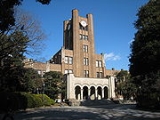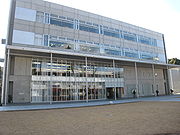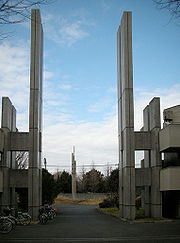
University of Tokyo, Komaba Campus
Encyclopedia
Being one of the five campuses of University of Tokyo, Komaba Campus is home to the department of the College of Arts and Sciences, the Graduate School of Arts and Sciences, the Graduate School of Mathematical Sciences, and a number of advanced research facilities and campus services. It’s the campus for all the freshmen and sophomores in undergraduate school. Therefore, every University of Tokyo student has spent at least two years in the Komaba Campus. University of Tokyo is the only University in Japan which has a system of two years of general education before the students get to choose their majors. In this system, the Komaba Campus is the cornerstone of the general education, and was designated as the “center of excellence” for three new areas of research by the Japanese Ministry of Education and Science. There are currently over 7,000 students in the junior division (freshmen and sophomores) for College of Arts and Sciences, about 450 students in the senior division, and 1,400 graduate students devoting in their studies.
 Cafeteria Wakaba is on the first floor of this building, and Dining Icho on the second. Both refectories can accommodate about 500 people.
Cafeteria Wakaba is on the first floor of this building, and Dining Icho on the second. Both refectories can accommodate about 500 people.
 Komaba Library is the second largest library of the University of Tokyo, after General Library on Hongo campus. It contains about 560,000 volumes. Reading rooms are on 2nd, 3rd, 4th floor. On the first floor are the counter, a lounge, computers for book searching, copy section, and Media Park, where students can make use of PCs. Students can borrow 5 books at a time and keep them for two weeks. In the basement there is a special collection of rarely borrowed books, or foreign language books, it has to be accessed via a special card given at the front office.
Komaba Library is the second largest library of the University of Tokyo, after General Library on Hongo campus. It contains about 560,000 volumes. Reading rooms are on 2nd, 3rd, 4th floor. On the first floor are the counter, a lounge, computers for book searching, copy section, and Media Park, where students can make use of PCs. Students can borrow 5 books at a time and keep them for two weeks. In the basement there is a special collection of rarely borrowed books, or foreign language books, it has to be accessed via a special card given at the front office.
There are 344 “circles” is the University of Tokyo. Exactly half of them are sports related clubs and the other half of them are cultural ones. Among sports clubs, there are 26 tennis clubs, 10 soccer clubs, 7 basketball, badminton, volleyball and alpine clubs, 5 ski clubs, 4 Aiki-do clubs and so on. Among 172 cultural clubs, 34 clubs are about music and the others are about various kinds of hobbies. If one enters the University of Tokyo and wants to join one, he/she is sure to find one that matches his interest, and if there is no “circle” that matches his/her interest, he/she can make one by him/herself. To attract various kinds of people who have the same interest, more than half of the clubs are inter-college clubs. There are clubs which is limited to the students who belong to the University of Tokyo.
2006
Baseball Club: Tokyo 6 University’s League in Spring, 2006: 6th
Tokyo 6 University’s Freshmen’s Cup: 4th
Tokyo 6 University’s League in Fall, 2006: 6th
2007
Baseball Club: Tokyo 6 University’s League in Spring, 2007: 6th
Lacrosse Blue Bullets: Freshmen’s Cup: 1st
 Located in Shinkawa, Mitaka City, Mitaka International Hall of Residence is home to most of the foreign students and is established to provide housing for Komaba students. The ratio between Japanese and international students are about 7:3, and the male to female ratio is 8:2. In each of 605 single rooms, there are equipped with basic furniture, kitchenette
Located in Shinkawa, Mitaka City, Mitaka International Hall of Residence is home to most of the foreign students and is established to provide housing for Komaba students. The ratio between Japanese and international students are about 7:3, and the male to female ratio is 8:2. In each of 605 single rooms, there are equipped with basic furniture, kitchenette
, shower and toilet, air-conditioner, and a telephone. Currently the monthly rent is 14,000 Japanese Yen (excluding the power and water fees), which is very low considering the regular rent in the Tokyo area. Although most of the Mitaka residents will only live in the residence for two years, the Mitaka International Hall of Residence does provide great help to the foreign students as well as Japanese students who just come to Tokyo for the education.
History
The Komaba Campus is located in Komaba, Meguro district, Tokyo. This area was called Komaba Meadows, served as hunting ground for the Tokugawa family. In 1878, the Komaba School of Agriculture was founded, and in 1919, the school became Faculty of Agriculture of the Tokyo Imperial University that is the predecessor of University of Tokyo. During World War II, many of the school buildings were destroyed and the new buildings were not built until the Faculty of Agriculture was transferred to Hongo Campus, and Komaba became Dai-ichi KotoGakko. The new buildings were constructed following the architectural styles of Hongo Campus. The Komaba Campus finally became the University’s College of General Education after incorporated into the postwar University of Tokyo, and later renamed as College of Arts and Sciences.Building.1
Building.1 is located in front of the Main Gate. This building is designated as Japanese cultural asset and it is one of symbolic buildings in Komaba. The clock tower is opened to the public twice a year and you can enter inside. Its shape is square with a courtyard and has about 50 rooms. On the second floor is Academic Guidance Center, which provides students with some information about shinfuri system and departments. On the third floor is Student Counseling Center, where students can consult counselors.Administration Office
Administration Office is a building on the right side of the Main Gate. Offices important for campus life are in this building. For example, Academic Affairs Division deals with reports submission and reissuing a student identification card. Student Support Division helps find part-time jobs, introduces lodgings, lends lecture rooms or equipments, and keeps unclaimed lost articles.Information Education Building
Information Education Building is on the left side of the Main Gate. In this building, students can use dozens of PCs. With a terminal, they can send or receive e-mails, surf the Net, build Websites, make reports, and so on. Students can bring their PC and connect it to the Net, as well as use the terminal.Auditorium
Auditorium is the largest lecture room in Komaba. It seats around 600 people. It is used for not only lectures, but also explanatory meetings of some organizations or concerts.Komaba Communication Plaza (Northern Complex)
CO-OP and Bookstore are in this building. Bookstore deals with from reference books or scientific books to magazines, literary works, and paperbacks.Komaba Communication Plaza (Southern Complex)

Campus Plaza
Campus Plaza consists of Complex. A, B, C. The Office, meeting rooms, music studios and clubrooms are in Complex. A and B. Theatrical circles use the hall in Complex. C and give public performances.Gakusei Kaikan
Many clubs called “circle” have their clubroom in this building. On the 1st floor are photocopiers or printing presses called Ges-pri which are used to print bills of a circle or prints for a terminal examination. Gakusei Kaikan is so crowded that numbered tickets have to be distributed before a school festival or a terminal examination.Komaba Library

Gymnasium 1, 2
Gymnasium 1, 2 are in the northern part of Komaba Campus. Gymnasium 1 has three floors. Students practice Judo, Kendo, table tennis, and ball games in it. In Gymnasium 2 is a space for badminton or basketball.Health Service Center Komaba Branch
Students can undergo a medical examination, or consult a doctor in Health Service Center. It has departments of Internal Medicine, Psychiatry, Orthopedics, Dentistry and Orthodontist, and Dermatology.Komaba Museum
The College Art Museum on the 1st floor of Komaba Museum and the College Science Museum is on the 2nd. Both Museums are open to the public. The College Art Museum houses pictures painted in Japanese style or Western style of the Meiji or Taisho Era, archaeological materials from ancient China, Korea and Japan, Andean folk materials, and so on. On the other hand, the College Science Museum possesses extensive samples of mineral ores, fungi and insects. Also exhibited are experimental apparatuses, measuring instruments, models for teaching which were used when Western science or engineering were introduced to Japan.Circles
There are as many as 344 clubs which are called “circle” in the University of Tokyo. The difference between a “circle” and a varsity (a team that represents the university) relies upon whether the club is given certain amount of money from the university or not. There is only one school team for each sport, but there can be plural “circles” for one sport. “Circles” can be divided into three groups; one group is the group of “circles” which belongs to Komaba Campus and another group is the “circles” which belongs to Student-Department and the other is the group which is not admitted by the university. It is important for “circles” and varsities to have newcomers every year so that they can exist. Every year, in April (when freshmen enters universities in Japan), every "circles" and varsities rush to grab some freshmen in their “circles”. It is called .There are 344 “circles” is the University of Tokyo. Exactly half of them are sports related clubs and the other half of them are cultural ones. Among sports clubs, there are 26 tennis clubs, 10 soccer clubs, 7 basketball, badminton, volleyball and alpine clubs, 5 ski clubs, 4 Aiki-do clubs and so on. Among 172 cultural clubs, 34 clubs are about music and the others are about various kinds of hobbies. If one enters the University of Tokyo and wants to join one, he/she is sure to find one that matches his interest, and if there is no “circle” that matches his/her interest, he/she can make one by him/herself. To attract various kinds of people who have the same interest, more than half of the clubs are inter-college clubs. There are clubs which is limited to the students who belong to the University of Tokyo.
Varsities
There are teams that represents the university called in Japanese. Most of the varsities are not so strong, but some varsities are very strong and famous. Here are the results of the varsities.2006
Baseball Club: Tokyo 6 University’s League in Spring, 2006: 6th
Tokyo 6 University’s Freshmen’s Cup: 4th
Tokyo 6 University’s League in Fall, 2006: 6th
2007
Baseball Club: Tokyo 6 University’s League in Spring, 2007: 6th
Lacrosse Blue Bullets: Freshmen’s Cup: 1st
Mitaka International Hall of Residence

Kitchenette
A kitchenette is a small cooking area.In motel and hotel rooms, small apartments, college dormitories, or office buildings a kitchenette usually consists of a small refrigerator, a microwave oven or hotplate, and, less frequently, a sink...
, shower and toilet, air-conditioner, and a telephone. Currently the monthly rent is 14,000 Japanese Yen (excluding the power and water fees), which is very low considering the regular rent in the Tokyo area. Although most of the Mitaka residents will only live in the residence for two years, the Mitaka International Hall of Residence does provide great help to the foreign students as well as Japanese students who just come to Tokyo for the education.

